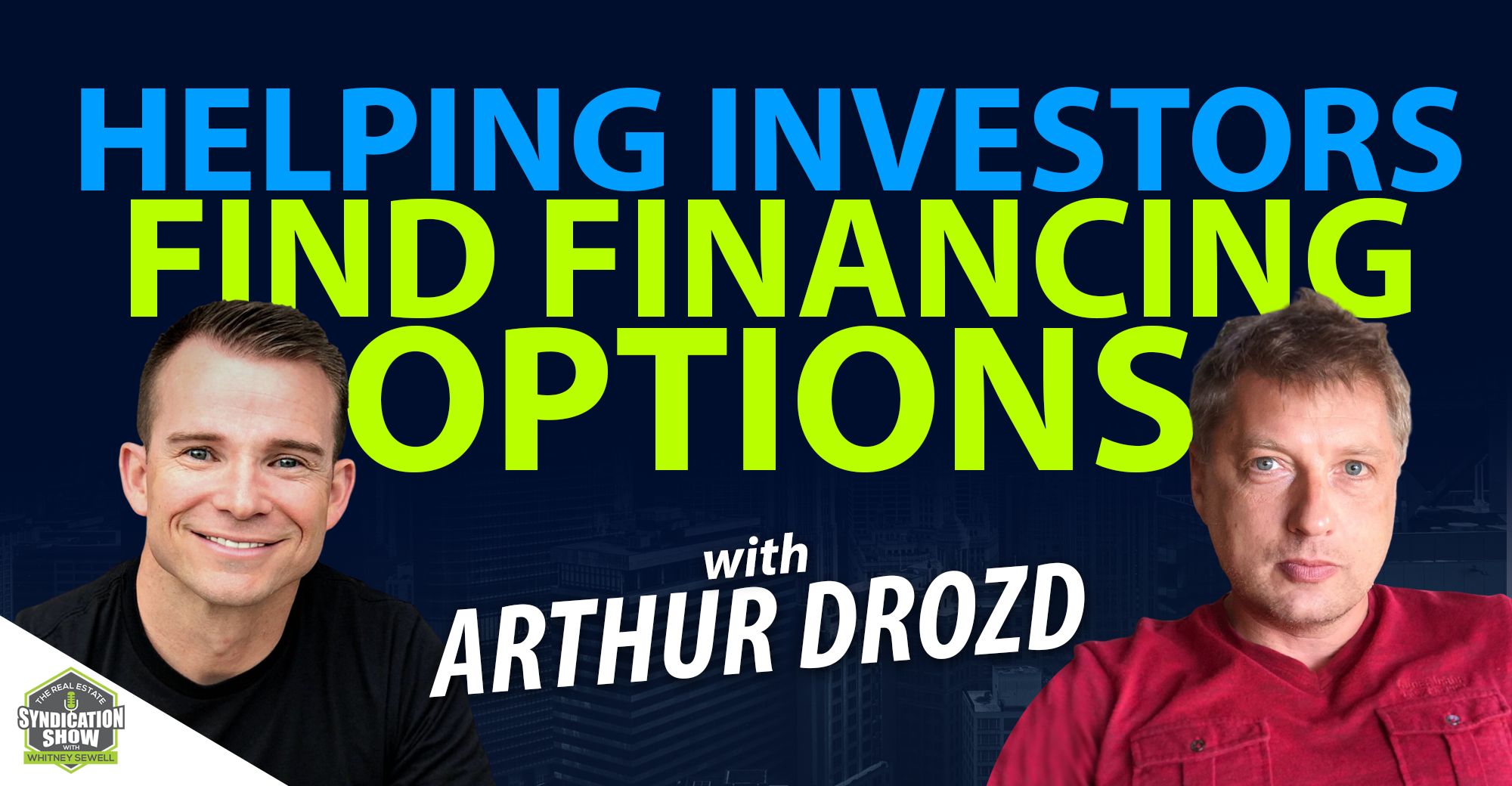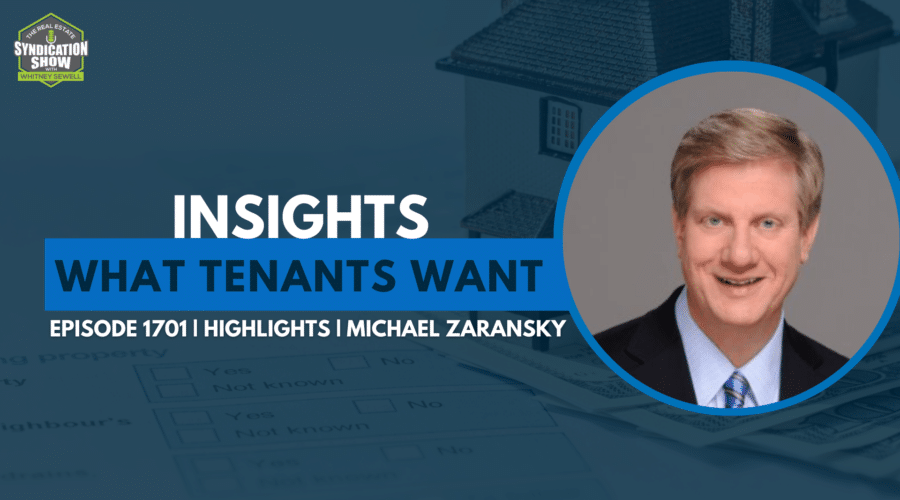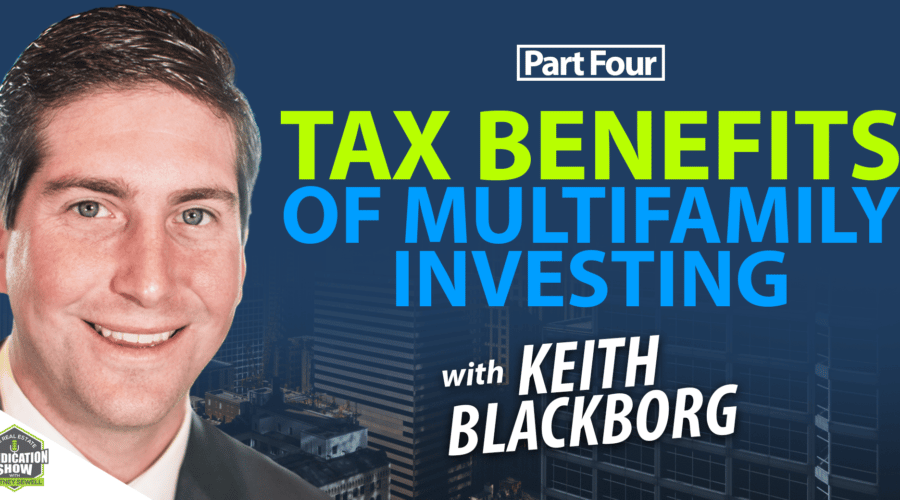Finding the right financing option will help you close your real estate deals. That’s why it is important to know where you can look for financing aside from the traditional lenders that are around. In this episode, Arthur Drozd of SDS Realty talks in detail about his commercial real estate loan platform, readylendgo.com.
Watch the episode here:
Listen to the podcast here:
Arthur starts by sharing his real estate journey and his market focus right now. Arthur owns and operates 364 multifamily units and mixed‐use properties with over $61 million under management. He shares that he’s focussing now on markets with more value-add potential, less rent control, and that are located in more landlord-friendly states. He also elaborates how he came up with the online platform that aims to help investors identify financing options. Tune in now and learn more about this tool that you may find helpful!
Key Points From This Episode:
- Arthur shares he started listening to the Real Estate Syndication Show during the lockdown due to the Covid-19 pandemic and that he had learned a lot.
- Arthur talks about his journey in the real estate industry and what his focus is right now.
- Arthur describes what his business is like today. He shares that he is focussing now on markets with more value-add potential, less rent control, and more landlord-friendly states.
- Why is there a demand for newer properties?
- Arthur explains why he is also trying to keep more value-add deals.
- Arthur talks about the tool that he created to help investors identify financing options: readylendgo.com, a commercial real estate loan platform.
- The website currently has 33 lenders and growing which focuses on markets in California, Nevada, Oklahoma, Texas, Indiana, and Illinois.
- Arthur hopes the website can help many investors finance their deals.
- How to find the right financing options for your deals? How to read profit and loss (PnL) the correct way?
- Arthur emphasizes the importance of having a good relationship with your broker.
- How does Arthur prepare for a potential downturn?
- Arthur’s best source for meeting new investors right now.
Tweet This!
“I’m getting out slowly out of California into markets that still have value-add potential, less of rent control, (and) more of landlord-friendly states.” [0:08:25]
“I like new products because a lot of people right now want to live in a suburbs and they want to have home offices, and they want a room for their kids to play around, and the home base is more important right now. So, my focus right now is newer properties.” [0:09:02]
“If you don’t know the market really well or you don’t know the financing in that market, you kinda have to knock on every door. So, I realized that maybe there should be a tool that’s much easier. I figured it would be easier if there could be a site that you can plug in your information for financing or refinancing this particular commercial or multifamily property, and this is how much money down and this is how much money it makes. And then it automatically puts you together with the right lender.” [0:11:58]
“I hope that we can help people finance their deals and refinance their deals, and create a much larger platform for that.” [0:15:20]
Links Mentioned in Today’s Episode:
About Arthur Drozd
Arthur Drozd was born in Moscow, Russia, and grew up in the Soviet Union. After military service, he emigrated to the United States and settled in the San Francisco Bay Area. Now, he is an experienced owner and operator of a commercial real estate investment firm with a background in automotive management, finance, and education in TV/Radio journalism and real estate management.
He owns and operates his real estate investment firm SDS Realty out of Fairfax California with management teams in 4 states. He has been in commercial real estate for over 13 years.
His first Real Estate purchases were during the Great Recession in Vallejo California while the City was going through bankruptcy. The risky bet paid off when the Bay Area Real Estate rental market exploded shortly after. He has specific experience in turning mismanaged or abandoned multi‐family assets into profitable businesses. His company now operates multi-family, single‐family, and commercial real estate across Indiana, Oklahoma, California, and Nevada. Currently, he owns and operates 364 multifamily units and mixed‐use properties with over $61 million under management.
Full Transcript
EPISODE 1139
[INTRODUCTION]
0:00:01.6
ANNOUNCER: Welcome to the Real Estate Syndication Show. Whether you are a seasoned investor or building a new real estate business, this is the show for you. Whitney Sewell talks to top experts in the business. Our goal is to help you master real estate syndication.
And now your host, Whitney Sewell.
0:00:23.00
Whitney Sewell (WS): This is your daily Real Estate Syndication Show. I’m your host, Whitney Sewell. Today, your co-host is David Robinson. David is a client of mine and he is doing big things in the real estate syndication industry. I know you are going to enjoy today’s show.
[INTERVIEW]
0:00:40.0
David Robinson (DR): This is your daily Real Estate Syndication Show. I’m your host, David Robinson. Today, our guest is Arthur Drozd. Arthur welcome to the show. I appreciate you coming on.
0:00:48.0
Arthur Drozd (AD): David, thanks for having me.
0:00:51.0
DR: So before we started the podcast, you had mentioned your experience during quarantine about listening to the Real Estate Syndication Show. Tell us a little bit about that.
0:01:00.0
AD: Oh yeah, I discovered it on, the gym was closed in California, so I had to do some other things, walking the woods, going on the beach, and I need to listen to some podcasts. And I actually found yours and I find out that it was 700 of them by that,s I think was done and I’m like, I missed so many. So I was listening 5 to 6 at a time until I was like, “Oh my God, this is the best thing I ever listened to.” On my daily walk, I was listening to your daily show and I learned a lot. I mean, it’s a lot of information seriously. This week I did a cost segregation study from the guys who suggested on three of my buildings in the LAs Vegas, I saved millions of dollars.
0:01:42.0
DR: That’s fantastic. Well, Whitney’s done an incredible job, and his team on where there’s done an incredible job, so I’m glad you’re finding a lot of value in the previous episode. So a little bit about Arthur. Arthur is an experienced owner and operator of a commercial real estate investment firm. He has specific experience in turning mismanaged or abandoned multifamily assets into profitable businesses. Currently, he owns and operates 364 multifamily units and mixed-use properties with over $61 million under management.
And Arthur, that’s just obviously a very, very short bio, maybe if we can start off, I’d love to back up a little bit and just hear a little bit more about your past experience and then bring us forward to what you’re focused on today.
0:02:28.0
AD: I was born in the Soviet Union, in Russia, and grew up in suburban Moscow in a communal apartment. My family had one room and four of us. It was me, my sister, and my parents who lived in one room about 300 square feet, and we share the bathroom and a kitchen with two other families, so real estate was in a short supply in Soviet Union. So that’s what happens when the government is trying to run housing.
So demand was high but supply was short. So yeah, I grew up in the Soviet Union, went to the military, Soviet army, and then immigrated into the United States, got married and started in car business first, and I was in the car business for about 15 years. Grew from being a salesman on the floor. It would take me to the dealership to a general manager of an Infiniti dealership, and then one of the part owners of automotive assets in the Far East. And the year 2009, I realized that it was a great time to get into real estate.
I always wanted to get into real estate, into commercial real estate primarily, but I couldn’t because the entry price was so, so high especially in Bay Area here. You couldn’t afford it, for a normal human being, especially an immigrant to save enough money to get into anything like that. But in 2009, I started going to the auctions and then looking at the properties that were offered, and I start realizing that everything that was offered was offered in pennies on the dollar compared to what the loans were. And they realized that there’s been an even bigger crashed because the banks are gonna lose an enormous amount of money at the time. So within probably a few months, I liquidated my portfolio savings and started investing into real estate here. At the time I was reading a book, it was a biography of the Rothschild family, and one of the founders there says that the best time to buy is when there’s blood on the streets and the famous word of the child. And I thought, “Wow, this is interesting” because at the time of properties in Bay Area didn’t drop as much, but there was only one town called Vallejo, a Bay Area town where properties were dropping much more than anywhere else. And the reason being is that Vallejo declared bankruptcy right around that time, it is one of the few cities in America that ever did. And they cut police and they cut fighters and they cut services. And I thought, “You know what, this would be probably the good time to buy it because we really are buying foreclosures.”
And I was lucky enough to get into it because a lot of people were afraid that it’s just gonna drop and there’s gonna be ab urban warfare, its crime, and which it did increase. There was a huge increase in murder rates and crime. But I kinda taught, “you know what it’s in the Bay Area, it’s right on the bay. It’s great weather. It’s a 30-minute ferry commute to San Francisco, so how bad can you get?” And so I was buying those properties and started flipping. And then I realized it is better to keep them, refurbish them, remodel, and rent almost the same people who left. There were even places where I could buy households in the street and control the narrative of who was gonna live there. And that part was actually really interesting because take a place that was boarded up and with a lot of streetwalkers and drugs and drug addicts, and then literally in three, four months, the whole neighborhood changed. And you see kids running around the writing bikes on the streets and a totally different feel for the neighborhood. So that was very uplifting and the same time, very profitable, because during the same time, San Francisco Bay Area, at a web-to-print home resurgence, and the market for rental real estate just exploded.
So I was thinking of buying it to time more in Vallejo, I had 12 buildings at the time there. We realized that I can’t because the capitals were out of the bag, everybody knew that that was a great deal. So I went to the next market, which was Sacramento. And Sacramento started exploding a couple of months after that. I was lucky enough to buy three buildings there and did well. The next market where people are gonna start moving out of California because it was too expensive, geographically it’s Nevada. So I started buying in Las Vegas, end up buying four apartment buildings there. And then the biggest exploded. So you couldn’t buy anything there that made any sense. So what’s next?
So I went to Oklahoma, which went to be a really good market for me. And then this year I started, I bought two buildings in Oklahoma closing today on the fourth one, and three buildings in Indiana.
0:07:23.0
DR: Well, thank you for giving us some insight into your past experience. And it sounds to me like you hit each of these markets at the perfect time. And just to give us some context, when you mentioned buying these buildings, 12 buildings originally in Vallejo, three in Sacramento, four in Las Vegas, three in Oklahoma, and then a couple of Indiana. You mentioned apartment buildings at one point, but then you mentioned single-family as well. So is this a mix of single-family and multifamily?
0:07:50.0
AD: So I started with single-family homes in Vallejo, went into duplexes and fourplexes in Vallejo. Then seven-unit buildings and then from there, anything going forward, it was two of the 14-unit buildings in Sacramento, and then Las Vegas already was 30 to 50 units. And then once I got into Oklahoma, it was already 70-unit buildings.
0:08:13.0
DR: I see. And what does your business look like today? It sounds like Indiana is your market of focus at this point. And if you can just describe what your business looks like today and what you’re focused on.
0:08:25.0
AD: I’m getting out slowly out of California into markets that still has value-add potential, less of rent control, more of landlord-friendly states. Nevada was focused for a while. Now, Oklahoma is as much larger, focussing in on $11.6 million transactions today in Oklahoma. And it’s mainly new construction. And other deals in the works there, 20 units of subdivision in the suburb of Oklahoma City as well as being finished this week, the certificate of occupancy. I like your products, because a lot of people are right now want to live in the suburbs and they wanna have home offices, and they went in the room for kids to play around and the home base is more important right now.
So my focus right now is newer properties, probably just incomplete or recently been completed in the last few years where your overhead and expenses for maintenance are not as high. To get it into something like it in California or even in the last year, I guess you’re buying usually building to build in the 60s to 70s. And on paper, it looks great. It’s fantastic, but when the broker shows you a pro forma, but once you start diving into what it really is gonna be, you start realizing that you are spending much more on a CAPEX. Because nobody’s gonna tell you that they’re selling the building because I need a new roof really, and the scoreline is collapsing. I mean you do your due diligence. But still, there’s a lot of things that are coming up.
0:10:07.0
DR: Sure, so you’re focused on buying newer buildings that still may have some sort of value-add components, would you say more of like a core plus asset type versus value-add?
0:10:18.0
AD: I’m trying to keep you value-add deals like Indiana are value-add deals because you have to kind of play both. If you wanna grow, the newer product is easier to manage, but it’s lower cap rates, but where you wanna build the funds that you’re gonna use later on for a 1031 exchange for larger properties is the value-add and that’s Indiana. Indianapolis right now is the market for me, I just bought three buildings there. You could buy buildings there still, that would be in six, seven caps, 8 caps, if you’re ready to spend some money remodeling and the rental market is really good there.
0:10:56.0
DR: I see, that makes sense. I appreciate you giving us some background, maybe let’s shift gears slightly here, and let’s talk about this product, this tool that you’ve created to help investors identify financing options. Maybe you just give us a brief summary.
0:11:11.0
AD: Yes, in the last two months, you can call it, I did six acquisitions. And it was really hard. I’m working on number seven right now, it’s approved, it should be closing in the next week or so. But it was really hard to find the right partners, the right banks. And what I realized is, every single time you go into a different market with a different product, it’s gonna be a different bank that will meet those criteria, and you never really know who is gonna be trusting of you, big banks like Wells Fargo somebody else. But they do not always do that, those deals in those markets. So you have to find local banks, and then if you don’t know the market really well, we don’t know the financing in that market, you can have to knock on every door.
So I realize that maybe there should be a tool that’s much easier. Landing three did that presidential while back, so I figured maybe it would be easier if there would be a site where you can plug in the information, financing over refinancing this particular commercial or multifamily property, and it’s how much money down, and this is what it makes, and then it automatically put you together with the right lender, ’cause by now, I really have a huge portfolio of lenders. I realized maybe this is gonna be much easier.
So I created a site called readylendgo.com. It’s a site where you put your information and it will show you the shops for you from your market for that particular product, for the best lender to pair you with.
0:12:54.0
DR: For those that may want an example, this is like a Kayak of lending or lending tree on the residential side, you plug in your information, the system matches you with a few prospective lenders that would be a match for your project. Correct?
0:13:10.2
AD: Correct.
0:13:11.0
DR: And so how have you aggregated all of the potential lenders? Do they subscribe on the back-end to readylendgo? Or have you had to reach out individually to them to get them to participate? How does that work?
0:13:28.0
AD: I had to reach out individually to start because everybody is ready for that. But to give you an example, if you were for example, in Indiana, my last two deals in Indiana, I did with a credit union where the teachers created union 80% LTV. It’s a fantastic deal. Nobody could ever come close to that, even the agencies and no origination fees. Very easy, very easy deal.
So I did both buildings at the same time with the one lender. So to find a deal like that that you don’t know where you’re looking at, what you’re looking for, it’s gonna be really hard. But that is just an example, right? Same, for example, even because you never know what bank or credit union specializes in what product. Some of them will be specializing in a particular area and particular product like storage or industrial. I have a lot of people right now looking for industrial space in Oklahoma because the cannabis business is booming there. It gives 10,000 licenses last year, more than California. So the industrial cannabis business is booming. A lot of people looking to get funding for that. And if you don’t know where to go, you don’t know.
0:14:42.0
DR: And so on the back end, at this point in time, this is a fairly new product that you’ve created. How many lenders do you have that are participating with you on the site?
0:14:53.0
AD: I have 33 lenders right now, and the number is growing.
0:14:55.0
DR: Is there a particular market focus at this point?
0:14:58.0
DA: Right now, it’s the market where I am at because I know those markets better. It’s California, Nevada, Oklahoma, Texas, Arkansas, and Indiana and Illinois markets. So those are the primary markets. But we’re gonna be expanding with larger companies as well.
0:15:15.0
DR: I see. And what do you see as the future for readylendgo?
0:15:18.0
AD: Oh, I hope that we can help a lot of people finance their deals and to refinance their deals, and create a much larger platform for that.
0:15:26.0
DR: That’s fantastic. Well, before we start to wind down here, I do want to just chat with you a little bit about this concept of finding the right financing for your deals, as well as being able to read a PnL the correct way. You mentioned that that’s sort of one of your focuses, is being able to read a PnL the correct way, maybe you shut some light on what you mean by that.
0:15:54.0
AD: I came from the car industry and my background was in finance, obviously in sales. So my first and foremost in the car business is just to look at your profit and loss state daily as a general manager of the dealership. So you have to be able to look at numbers and see where are they out of luck, so where are they out of proportion to the was supposed to be. Turn out that commercial real estate is the same thing.
So if you look at it and analyze the deal before you go buy it, you can see, “Okay, the rent is undermark compared to mark, but the expenses, for example, they’re really high.” How do you know they’re really high because you kind of know where the market should be on the water, on the electrical, landscaping, gardening, turns, maintenance. A lot of times, a broker sends you a deal and you look at it, then you think it’s a four and a half cap deal, why is the reason why nobody buys it is because it’s on the second-day market that’s been for in the healthcare.
You start looking into numbers, you realize that a lot of the expenses, mom and pop owners, they put the personal expenses into the business, and once you cut that out all the gardening that they did for their home and their second home or their car expenses for their car maintenance and car payments, all the fixing of the other properties that they poured into this building because it was hurting. Once you back it out, you realize you have a totally different option.
0:17:35.0
DR: You mentioned that you’ve acquired six, going on seven properties since Covid hit, so in the last roughly 12 to 18 months. There’s a lot of competition out there in the market today. And so how have you gone about finding those opportunities?
0:17:52.0
AD: It is relationships, and the relationships mainly with brokers. My primary three markets are expanding. In Las Vegas, Nevada, I have a very strong broker. Oklahoma I have a very strong broker. And Indiana, I have a very strong broker. And once you have those relationships my advice to you, take them to dinner. If you have time, you have an opportunity, so just connect.
0:18:16.2
DR: And how long did you foster those relationships before they actually turned into an actual opportunity that you could acquire?
0:18:24.0
AD: It depends. My first biggest deal, on Sunday I look up, and I see a deal as much as what I needed to. I call the number, hoping that there’s gonna be a voice mail. And the guy picks up, “Hello, this is blank.” And I’m like, “Oh my God, really commercial real estate on a Sunday, the broker answers the phone.” And I ended up buying the building, he end up selling three more buildings and selling the ones for me in the market, and he is an incredible worker, and that’s why when there’s the first opportunity, he knows that you’re gonna close if it’s a good opportunity, you’ll find a way to finance, you’ll find the money for the payment, you find partners if you need to. So they call you first, that’s what I mean when I say four-star goes, relationship with those brokers, This is because they’re gonna come to you with this first deal, the same deal happened to me with Derek in Oklahoma, the Indianapolis market. Same situation.
0:19:21.5
DR: Yeah, it’s critical, right?
0:19:24.0
AD: When a good deal falls out somewhere and you were part of it before, you’re the first one they call. I have a good deal for you, and you could add value to it and you know, your boom. At least on paper, you just made a million dollars.
0:19:38.0
DR: Love it. Arthur, we need to start winding down here, but I’ve got a few final questions for you, the first is, how are you preparing for a future downturn?
0:19:48.0
AD: I put a lot of effort into securing lines of credit because cash is not what you will need if something happens. So if you have the properties that appreciate it already or they paid off, you should have at least three months worth of cash on the sidelines for up to six months into the lines of credits that you can enter any time and use to fix that or problems you can post have. So apply for them now, don’t wait until the downturn, and get that done now, so you can sleep better if all of a sudden 50% of you can stop paying rent for whatever reason, you can’t evict and the government doesn’t pay, which is happening right now.
0:20:34.0
DR: Are these lines of credit subject to arbitrary cancellation by the lender.?
0:20:40.0
AD: No, I have never seen it. Major banks don’t do that, Wells Fargo, Bank of the West, US Bank, and those are the ones that I have lines are created with. So if I need to, I can always use those lines of credit to cover me until…
0:20:56.0
DR: Next question I’ve got for you is, what’s the best way for you to find investors today?
0:21:00.0
AD: Relationships. A lot of dinners, a lot of wine, good wine.
0:21:05.0
DR: I love it. And how do you connect with those people to actually get those dinners set up?
0:21:22.0
AD: The referrals mainly, it’s people who already done business with you and know that you’re gonna deliver, you’re gonna close and we’re gonna deliver and gonna do what you say you’re gonna do. And that’s primarily in this business, this is the most important part. You have to do what you said you’re gonna do.
0:21:25.0
DR: Well Arthuer, I’ve enjoyed our conversation today. Thanks for sharing a little bit about your background and your experience growing up in the Soviet Union and immigrating here to the US. And your experience in the car business and then transitioning to real estate. And congratulations on your success in hitting those markets at the right timing for each of those markets and what you’ve accomplished thus far. And then talking to us a little bit about the new product that you’re pushing out, readylendgo, and the way that that can help prospective investors find the best financing available for that particular project. And lastly, some strategies and tactics about finding opportunities and networking with brokers.
Arthur, what’s the best way for our listeners to connect with you and learn more about what you have going on?
0:22:10.0
AD: I’m on LinkedIn, and this is the best way, probably, Arthur Drozd. Or they can email me straight if they have questions, I’m always ready to answer. My email is [email protected].
0:22:29.0
DR: We’ll have contact info in the show notes, feel free to reach out to Arthur. Again, Arthur, thank you so much for coming to the Real Estate Syndication Show. And we look forward to connecting with you again.
[END OF INTERVIEW]
[OUTRO]
0:22:42.7
ANNOUNCER: Thank you for listening to the Real Estate Syndication Show, brought to you by Life Bridge Capital. Life Bridge Capital works with investors nationwide to invest in real estate while also donating 50% of its profits to assist parents who are committing to adoption. Life Bridge Capital, making a difference one investor and one child at a time. Connect online at www.LifeBridgeCapital.com for free material and videos to further your success.
[END]
Love the show? Subscribe, rate, review, and share!
Join the Real Estate Syndication Show Community:






